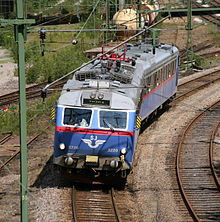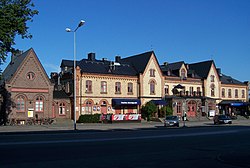Viscadalsbanan
| Borås-Varberg | |||||||||||||||||||||||||||||||||||||||||||||||||||||||||||||||||||||||||||||||||||||||||||||||||||||||||||||||||||||||||||||||||||||||||
|---|---|---|---|---|---|---|---|---|---|---|---|---|---|---|---|---|---|---|---|---|---|---|---|---|---|---|---|---|---|---|---|---|---|---|---|---|---|---|---|---|---|---|---|---|---|---|---|---|---|---|---|---|---|---|---|---|---|---|---|---|---|---|---|---|---|---|---|---|---|---|---|---|---|---|---|---|---|---|---|---|---|---|---|---|---|---|---|---|---|---|---|---|---|---|---|---|---|---|---|---|---|---|---|---|---|---|---|---|---|---|---|---|---|---|---|---|---|---|---|---|---|---|---|---|---|---|---|---|---|---|---|---|---|---|---|---|---|
|
Varberg station
| |||||||||||||||||||||||||||||||||||||||||||||||||||||||||||||||||||||||||||||||||||||||||||||||||||||||||||||||||||||||||||||||||||||||||
| Route number : | 77 | ||||||||||||||||||||||||||||||||||||||||||||||||||||||||||||||||||||||||||||||||||||||||||||||||||||||||||||||||||||||||||||||||||||||||
| Course book range : | 67 | ||||||||||||||||||||||||||||||||||||||||||||||||||||||||||||||||||||||||||||||||||||||||||||||||||||||||||||||||||||||||||||||||||||||||
| Route length: | 84 km | ||||||||||||||||||||||||||||||||||||||||||||||||||||||||||||||||||||||||||||||||||||||||||||||||||||||||||||||||||||||||||||||||||||||||
| Gauge : | 1435 mm ( standard gauge ) | ||||||||||||||||||||||||||||||||||||||||||||||||||||||||||||||||||||||||||||||||||||||||||||||||||||||||||||||||||||||||||||||||||||||||
| Power system : | 15 kV, 16.7 Hz ~ | ||||||||||||||||||||||||||||||||||||||||||||||||||||||||||||||||||||||||||||||||||||||||||||||||||||||||||||||||||||||||||||||||||||||||
| Top speed: | 110 km / h | ||||||||||||||||||||||||||||||||||||||||||||||||||||||||||||||||||||||||||||||||||||||||||||||||||||||||||||||||||||||||||||||||||||||||
| Operating points and routes | |||||||||||||||||||||||||||||||||||||||||||||||||||||||||||||||||||||||||||||||||||||||||||||||||||||||||||||||||||||||||||||||||||||||||
|
|||||||||||||||||||||||||||||||||||||||||||||||||||||||||||||||||||||||||||||||||||||||||||||||||||||||||||||||||||||||||||||||||||||||||
Viskadalsbanan is a standard-gauge railway line in Sweden that connects the cities of Borås and Varberg . The name of the route is an art term that only came about in 1990 when the name was given by Banverket , long after the routes were built under other names.
history

While Borås received a rail connection as early as 1863, it was not planned to connect Varberg to the Västra stambanan until 1870 . The private company Varberg-Borås Järnväg (WBJ after the spelling Warberg that was used when the company was founded ) was granted the concession to build the railway in 1876. The first freight trains ran between Varberg and Björketorp as early as 1879, and the official opening of the entire route from Varberg to Borås Nedre took place on October 25, 1880. In 1919 the WBJ created a joint administration with the Borås-Herrljunga-Bana, and the two railways finally merged to form the Varberg-Borås-Herrljunga Järnväg (VBHJ) in 1930. As a result of this merger, Borås Nedre station was renamed Borås Central on May 15, 1930. Ten years later the state took over the VBHJ. In 1949 the entire Varberg – Borås – Herrljunga line was electrified.
First, passenger traffic with electric multiple units of the X7 series was started. These were later replaced by the X17 series , which in turn was replaced by the X9 railcars ( Paprikatåg ) in 1979 .
The suspension of passenger traffic was discussed in connection with the planned closures of routes in the early 1980s. In 1986 Statens Järnvägar was able to reach an agreement with the transport company Älvsborgstrafik for the continued operation of the route.
The X9 railcars continued to be used, however they were not very reliable. The timetable times have been extended to safeguard travel times. Three three-car trains were converted to one-man operation, were given a new coat of paint and were used under the name Viskadalen . The last of the trains was parked in the summer of 1998, and X12 multiple units have been on the line since then.
route
Shortly after Borås, the Viskadalsbana branches off from the Kust till kust-bana and, with a short break (Fritsla– Kinna ), follows the valley of the river Viskan downstream to the coastal town of Varberg, where it joins the West Coast Railway shortly before.
traffic
The route is operated by Statens Järnvägar AB (SJ) on behalf of Västtrafik , with many trains continuing on the Älvsborgsbana towards Herrljunga / Uddevalla . The route is only occupied by a few freight trains, Green Cargo serves the Varberg – Veddige section. The concrete industry in Järlöv is also a freight customer.
Individual evidence
- ↑ Additions according to Dr. Koch 1939
- ↑ Speed table of the Swedish railways (PDF; 123 kB)
- ↑ Description of the route at järnveg.net. jarnvag.net, accessed January 7, 2016 (Swedish).
- ↑ according to banvakt.se Bandel 498
- ↑ WBJ and VBHJ
- ↑ Historia. jarnvag.net, accessed January 13, 2016 (Swedish).
